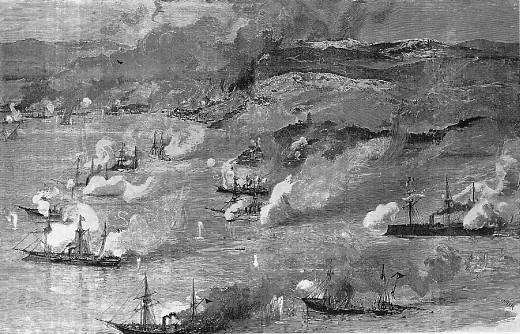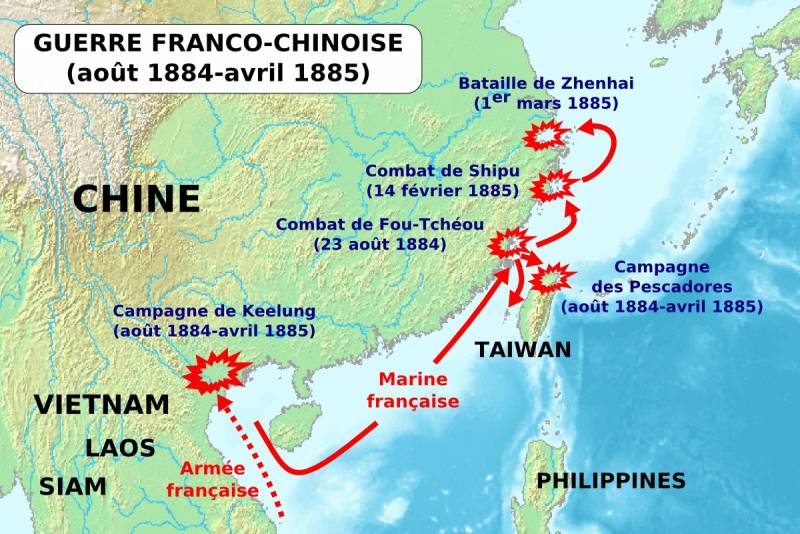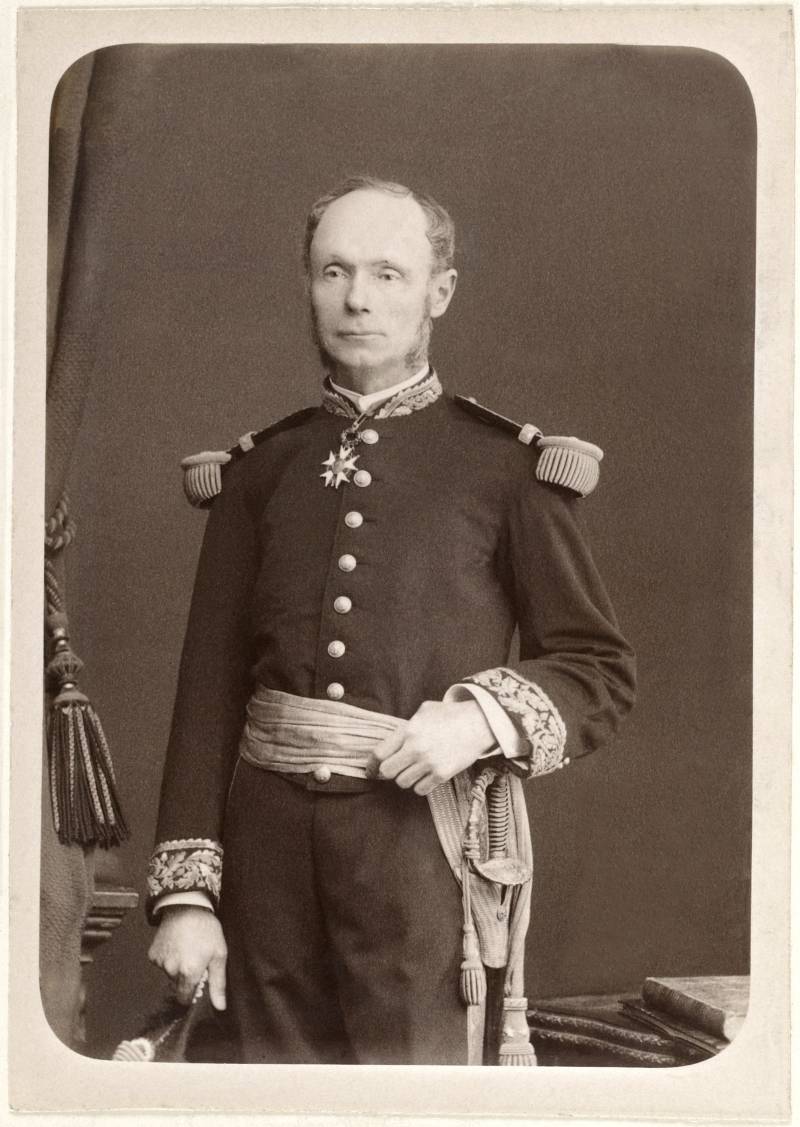Vietnamese whim of France. Part of 1
The French faced fierce resistance not only from Chinese troops from the provinces of Guangxi and Yunnan, but also from the Black Flag Army, which was led by Liu Yongfu. Bringing this confrontation to a quick victory was prevented by a new war, namely with China, which began in 1883 year. And so France had to transfer considerable forces to a new front of hostilities.
France on the warpath
Tonkin turned out to be an apple of contention for France and China. The fact is that the Red River flowed through northern Vietnam, which connected the southern province of China with the sea. And control of it was vital to the Qing Empire. Therefore, the authorities could not just sit and watch as the territory was being tidied up by the French. And in the summer of 1883, regular Chinese troops arrived in Tonkin. Together with the Vietnamese troops and detachments of Chinese settlers, they had to fight back the Europeans.
The first clash between the Chinese and the French happened at the very end of 1883 of the year. Admiral Amedey Courbet, who had previously been the governor of New Caledonia, led the Shontey operation. The main task is to capture the well-fortified and strong fortress of Shontei. With the task, Kurbe managed. However, in that battle he lost about four hundred soldiers. The Chinese warriors, for example, killed about two thousand. Therefore, the victory was perceived as Pyrrhic. In parallel with Courbet in Tonkin acted the new commander of the French army, General Charles Millau. In March, 1884, he, heading the ten thousandth army, managed to defeat the enemy's army, which outnumbered him almost twice. The Chinese settled in Baknin and prepared for defense. But Millau did not go head-on. Instead, the Frenchman, in secret from the enemy, led his army to the rear of the enemy. And when the Chinese saw the Europeans, they did not even think about defense. Instead of fighting, they abandoned fortifications along with weapons and fled. There were only a few minor clashes, respectively, the losses on both sides were minimal. And Millau managed to dislodge the Chinese from the valley of the Red River.
The frightened Chinese decided to quickly make peace with the French. And in May, 1884, in Tianjin, the parties entered into an agreement. According to it, the Chinese pledged to withdraw their troops from northern Vietnam, and also to recognize all the treaties between France and Vietnam. And in early June, 1884 France, having agreed with Vietnam, officially established its protectorate over it. But the governors of the southern provinces of China did not agree with this development of the plot. And they decided to continue the fight with the Europeans.
And at the end of June an incident occurred. The French detachment, which was moving along the road linking the Vietnamese city of Hanoi with settlements on the border with China, near Bacley faced the Chinese army. The superiority of forces was on the side of the Chinese - four thousand against seven hundred and fifty Europeans. The French, guided by the treaty, demanded that they leave Vietnam. But suddenly the Chinese attacked. The French army was forced to retreat, losing about a hundred people. The incident will anger the French government. And in July 1884, French Foreign Minister Jules Ferry issued an ultimatum to the Chinese government. Ferry demanded the immediate withdrawal of Chinese troops from Vietnam and the payment of contributions in the amount of two hundred and fifty million francs. For all this, the Minister gave time until the first of August. And if the Chinese refuse to comply with the conditions, Ferry announced that his soldiers would destroy the shipyards at Fuzhou and seize the coal mines at Jilong (Taiwan).
In fact, the Chinese government had no choice. But to agree to all the conditions it is not. The Qing officials said they were ready only to withdraw the troops and pay a contribution of three and a half million francs. Naturally, Ferry did not accept this counter offer and ordered the start of hostilities.
The interesting thing is that the land and sea forces of France operated separately from each other. And so, in Northern Vietnam and off the coast of China, two independent theaters of military operations developed.
Ferry's government placed special hopes on the Far Eastern squadron of Admiral Amedey Kurbe. It consisted of four armored cruisers, thirteen large and small non-armored cruisers, as well as several gunboats. The advantage was on the side of Courbet, since at that time the Chinese fleet was practically nothing. The fact is that by the beginning of the hostilities he had not yet been formed. And those ships that were built for China in Germany, at the request of Ferry, were “accidentally” detained in shipyards. Therefore Courbet was opposed only by weak and outdated ships. True, the Chinese had one trump card - powerful coastal batteries.
But Kurbe could not attack the coastal centers of China. Firstly, he still lacked the strength to do this. Secondly, a direct attack on these territories could have provoked Britain to take active steps, since it also included those lands in the category of its interests. And Kurbe received special instructions from the government to “work” only from Fuzhou and Taiwan.
And on August 5, Courbet began to act. His squadron attacked Jilong, which was located in northern Taiwan. First there was shelling, and then - an attempt to land the troops. But the Chinese managed and repulsed the attack. The Chinese authorities have responded to the incident quite, let's say, in a peculiar way. The Qing officials did not take the attack seriously as a full-fledged start of hostilities. Therefore, they looked through their fingers at the French ships that were walking along the river to Fuzhou, just past the coastal batteries. In fact, the Chinese could shoot them relatively easily and not allow the enemy to realize their plan. But the soldiers simply looked at the ships and did nothing, waiting for the commanding command. In the end, it came to the fact that the French and Chinese warships were just standing next to each other. And in late August, when the squadron gained enough strength, Courbet attacked the enemy.
Battle of Fuzhou
In total, the French gathered five military vessels, one of which was a large armored cruiser. The Chinese could oppose only a menacing force with only five small cruisers and four gunboats. The alignment of forces was obviously on the side of the Europeans, since their ships were modern and well armed. Naturally, when the French suddenly opened fire, the Chinese fleet, as they say, "merged." Most of the ships did not even have time to offer little resistance before they were sunk. The situation was aggravated by the fact that Admiral Zhang Peilun was on the shore at the time of the attack. Therefore, in the “beating of babies” he acted exclusively as an observer. It is not precisely known whether the attack during the absence of Peilun is pure coincidence or the French acted according to plan. But the fact remains.
Herbert Wilson wrote in his book “Battleships in battle”: “The day passed by day, and the opponents all stood against each other, while neutral ships hourly expected to see the attack that had begun. The French were always on full alert, the upper spar was lowered, everything was made to anchor the anchor ropes, the teams were in shifts with the guns.
The rumor was spread daily that it was precisely this day that was set to attack, but since the days passed without any special cases, the vigilance of the Chinese, which never, however, was particularly high, weakened more and more. The French were awaiting the arrival of the Triomfan, while the Chinese, being under the enemy guns directed at them, might have imagined that the French really did not plot anything bad against them. From this delusion, they were spared the most cruel way. In the evening of August 22, on Friday, Kurbe gathered all the officers on the flagship and explained his plan to them. The next day, shortly before two o'clock, at low tide, should be removed from the anchor and prepare for decisive action. At a signal from the admiral, the destroyers had to go ahead and attack the enemy: No. 45 - “Yan-Wu”, and No. 46 - “Fu-Sin”. On the secondary signal, "D'Estaing," "Villard," and "Duge-Truen" should have opened fire from the left side at Chinese steamers standing against them, and from the right board - at the junks at the Pagoda. Having finished with the enemy, "Duge-Truen" had to lower the barges and help the "Volta", which was ordered to cover the destroyers and from both sides to shoot at junks. To top it off, the three gunboats had to go ahead and destroy the Chinese ships at the arsenal. ”
The battle took place on the twenty-third of August 1884. Courbet, receiving an order to attack, ordered to prepare for battle. And the French, trying not to attract the attention of the Chinese ahead of time, began to breed couples. Then the ships were removed from the anchors and took places according to their combat schedule. This, of course, could not go unnoticed by the Chinese. They, too, began to prepare for battle.
According to Courbet’s plan, the battle was to begin with the attack of two destroyers. And their explosions were the signal to start the battle. But the plan did not work because of the human factor. Even before approaching the enemy, a shot was fired from one of the destroyers. Enraged Kurba had no choice but to order to raise the red flag. So the battle began.

Wilson wrote:
French gunners were very intense fire. The continuous hail of Hotchkis cannon shells mounted on the Mars ships of the French warships swept down enemies like mowers mowing wheat. Shifts of people to replenish the loss of a gun maid did not keep up quickly enough to run out from below. Small shells pierced the sides and vessel fastenings. More people were killed by shrapnel, scattering in different directions.
... About this battle, if only it can be called such, the French authors spoke of a brilliant affair. He was given the name "the famous battle of Fuzhou." But in essence, it differed very little from the slaughter, so that, although it was caused by necessity, it does not deserve such brilliant praise. It can be equated to actions of the same type as the bombardment of Alexandria. Both of these operations were undertaken against insufficiently trained people, and in both cases, Westerners caused very large losses to the east. Courbet’s great fame was based more on his professional knowledge and energy in developing his plans than on the great results that came out of this battle. His enemy was worthy of contempt. ”
But the Chinese, to give them their due, were not going to give up. Of course, they understood that the battle was lost, but they made another attempt to inflict any damage on the French. And at about sixteen o'clock the Chinese launched burning rafts into battle, which were sent to French ships. In parallel, shore batteries came to life. But the battle, as such, again failed. Opponents only exchanged shots. And soon Courbet decided that it’s time to finish. And ordered his ships to depart. According to official figures in the battle, the French lost only six people killed, another twenty-seven were injured of varying degrees of severity. And only one destroyer was put out of action. The losses of the Chinese, of course, were much more serious. They lost all the ships and more than five hundred people. Of these, five were senior commanders, and thirty-nine more were officers. As for Zhang Peilun, he, as mentioned above, was on land during the battle. And seeing his fleet dying, Peilun fled, hiding in a village near Fuzhou. Looking ahead, it is worth saying that this flight cost him a career. But Zhang still got off easily compared to the two captains who had abandoned their ships. They were executed for their cowardice.
But the battle of Fuzhou did not end in one day. Here is what Wilson wrote:
And only after the end of the battle, that is, on the twenty-seventh of August, did the Chinese government decide to declare war on France. And it was not going to surrender, forcing, thereby, the enemy to more active actions. The fact is that Ferry and his entourage hoped for a quick end to the confrontation. Ideally, immediately after the victory of Courbet. But the plan failed. China did not “merge”, but decided to fight with the European power. Another interesting fact: in France itself, the war has not officially been declared to China. The fact is that such a step required the approval of the parliament, and Ferri did not have strong support in order to realize his plans and ambitions. Therefore, he decided to do without this "little things" (the encouragement of parliament), which only hindered.
Further events
In September, Courbet continued fighting. At first, he began to "peck" Jilong (coast of Taiwan). After a powerful bombardment, a landing force landed here. The task was simple - to capture Jilong. But the French did not cope, faced with fierce resistance from Asians. Nor did Kurbe gain fame in the battles near Tamsui. Here the Chinese also managed to repel the attack of the Europeans.
Nevertheless, the standoff was delayed. The Chinese, not wanting to give in to the enemy, promptly transferred reinforcements to Taiwan. And it got to the English courts. Courbet responded to this step accordingly - he announced the blockade of the island. True, the admiral miscalculated and made not deliberate step. The fact is that after learning of the blockade, the United Kingdom woke up and quickly sent a protest to the French government. Ferry, and actually Amedea, had no choice but to announce the lifting of the blockade. True, the French, not wanting to obey the British, opened Taiwan only formally. In fact, the blockade continued. The British, of course, knew about it, but decided to close their eyes and watch further events. And at the very beginning of 1885, reinforcements arrived to the island to the French.
The Chinese understood that Taiwan would not last long. Therefore, it was decided to send a squadron of Admiral Wu Ankan to the liberation of the island, the main striking force of which was four large cruisers. On the way to them several more military courts were to join. But Li Hongzhang - one of the most influential dignitaries of the Qing Empire - decided that the northern Beiyang squadron at that moment was more necessary in Korea, since relations with Japan were very hot there.
Ships At Ankan reached the Taiwan Strait only in February. But ... seeing the French, they turned around and tried to hide from Courbet. True, this plan failed. Amedey, commanding an impressive flotilla, set off in pursuit. Opponents met on the thirteenth of February near Chusan Island, off the coast of Zhejiang Province. Wu Ankan understood that it would not work with the French and made a second attempt to escape.
Here is what Wilson wrote about these events:
After these events, the French decided to finish off China in another way. Since they could not prevent the maritime trade of the enemy because of Britain, they announced a rice blockade. Simply put, rice shortages quickly appeared in northern China, as they were supplied to them from the south, and the south controlled France. And the Europeans carefully inspected all the ships and if they found rice, the ship was simply turned back. And Kurbe, meanwhile, was not sitting back, as they say. Waiting for the advance of French soldiers in northern Taiwan, he managed to capture the Pescador Islands located in the Taiwan Strait. Then Amedey managed to capture the enemy fortifications on the island of Magnun. And the admiral decided to make them the main base of his squadron.
Продолжение следует ...


Information